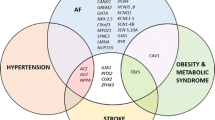Abstract
Atrial fibrillation (AF) is the most common clinical arrhythmia and a major risk factor for stroke. To investigate the role of genetic factors in a typical clinical population, we determined the extent of familial aggregation in patients with lone AF. To estimate the relative risk to family members, the prevalence of AF for each class of relative was compared to the prevalence in the comparable age and sex group from the general population. Family members had an increased relative risk of AF compared to the general population (risk ratio; 95% confidence intervals): sons (8.1; 2.0–32), daughters (9.5; 1.3–67), brothers (70; 47–102), sisters (34; 14–80), mothers (4.0; 2.5–6.5) and fathers (2.0; 1.2–3.6). Relatives of probands with lone AF are at a substantially increased risk of developing this arrhythmia suggesting a Mendelian genetic contribution to the etiology of this common trait.

Similar content being viewed by others
References
Allessie MA (1997) Is atrial fibrillation sometimes a genetic disease? N Engl J Med 336:950–952
Benjamin EJ, Wolf PA, D’Agostino RB, Silbershatz H, Kannel WB, Levy D (1998) Impact of atrial fibrillation on the risk of death: the Framingham Heart Study. Circulation 98:946–952
Bertram H, Paul T, Beyer F, Kallfelz HC (1996) Familial idiopathic atrial fibrillation with bradyarrhythmia. Eur J Pediatr 155:7–10
Brand FN, Abbott RD, Kannel WB, Wolf PA (1985) Characteristics and prognosis of lone atrial fibrillation. 30-year follow-up in the Framingham Study. JAMA 254:3449–3453
Brugada R, Tapscott T, Czernuszewicz GZ, Marian AJ, Iglesias A, Mont L, Brugada J, Girona J, Domingo A, Bachinski LL, Roberts R (1997) Identification of a genetic locus for familial atrial fibrillation. N Engl J Med 336:905–911
Chen YH, Xu SJ, Bendahhou S, Wang XL, Wang Y, Xu WY, Jin HW, Sun H, Su XY, Zhuang QN, Yang YQ, Li YB, Liu Y, Xu HJ, Li XF, Ma N, Mou CP, Chen Z, Barhanin J, Huang W (2003) KCNQ1 gain-of-function mutation in familial atrial fibrillation. Science 299:251–254
Chugh SS, Blackshear JL, Shen WK, Hammill SC, Gersh BJ (2001) Epidemiology and natural history of atrial fibrillation: clinical implications. J Am Coll Cardiol 37:371–378
Darbar D, Herron KJ, Ballew JD, Jahangir A, Gersh BJ, Shen WK, Hammill SC, Packer DL, Olson TM (2003) Familial atrial fibrillation is a genetically heterogeneous disorder. J Am Coll Cardiol 41:2185–2192
Ellinor PT, Shin JT, Moore RK, Yoerger DM, MacRae CA (2003) Locus for atrial fibrillation maps to chromosome 6q14–16. Circulation 107:2880–2883
Ellinor PT, Moore RK, Patton KK, Ruskin JN, Pollak MR, MacRae CA (2004) Mutations in the long QT gene KCNQ1 are an uncommon cause of atrial fibrillation. Heart 90:1487–1488
Fox CS, Parise H, D’Agostino RB Sr, Lloyd-Jones DM, Vasan RS, Wang TJ, Levy D, Wolf PA, Benjamin EJ (2004) Parental atrial fibrillation as a risk factor for atrial fibrillation in offspring. JAMA 291:2851–2855
Frustaci A, Chimenti C, Bellocci F, Morgante E, Russo MA, Maseri A (1997) Histological substrate of atrial biopsies in patients with lone atrial fibrillation. Circulation 96:1180–1184
Gabriel SB, Salomon R, Pelet A, Angrist M, Amiel J, Fornage M, Attie-Bitach T, Olson JM, Hofstra R, Buys C, Steffann J, Munnich A, Lyonnet S, Chakravarti A (2002) Segregation at three loci explains familial and population risk in Hirschsprung disease. Nat Genet 31:89–93
Go AS, Hylek EM, Phillips KA, Chang Y, Henault LE, Selby JV, Singer DE (2001) Prevalence of diagnosed atrial fibrillation in adults: national implications for rhythm management and stroke prevention: the AnTicoagulation and Risk Factors in Atrial Fibrillation (ATRIA) Study. JAMA 285:2370–2375
Guo SW (1998) Inflation of sibling recurrence-risk ratio, due to ascertainment bias and/or overreporting. Am J Hum Genet 63:252–258
Haissaguerre M, Jais P, Shah DC, Takahashi A, Hocini M, Quiniou G, Garrigue S, Le Mouroux A, Le Metayer P, Clementy J (1998) Spontaneous initiation of atrial fibrillation by ectopic beats originating in the pulmonary veins. N Engl J Med 339:659–666
Hiss RG, Lamb LE (1962) Electrocardiographic findings in 122,043 individuals. Circulation 25:947–961
Khoury MJ, Beaty TH, Liang KY (1988) Can familial aggregation of disease be explained by familial aggregation of environmental risk factors? Am J Epidemiol 127:674–683
Kopecky SL, Gersh BJ, McGoon MD, Whisnant JP, Holmes DR Jr, Ilstrup DM, Frye RL (1987) The natural history of lone atrial fibrillation. A population-based study over three decades. N Engl J Med 317:669–674
Leboyer M, Bellivier F, Nosten-Bertrand M, Jouvent R, Pauls D, Mallet J (1998) Psychiatric genetics: search for phenotypes. Trends Neurosci 21:102–105
Nattel S (2002) New ideas about atrial fibrillation 50 years on. Nature 415:219–226
Poret P, Mabo P, Deplace C, Leclercq C, Gras D, Marec BL, Daubert C (1996) Is isolated atrial fibrillation genetically determined? Apropos of a familial history. Arch Mal Coeur Vaiss 89:1197–1203
Risch N (1990) Linkage strategies for genetically complex traits. I. Multilocus models. Am J Hum Genet 46:222–228
Risch NJ (2000) Searching for genetic determinants in the new millennium. Nature 405:847–856
Rybicki BA, Elston RC (2000) The relationship between the sibling recurrence-risk ratio and genotype relative risk. Am J Hum Genet 66:593–604
Scardi S, Mazzone C, Pandullo C, Goldstein D, Poletti A, Humar F (1999) Lone atrial fibrillation: prognostic differences between paroxysmal and chronic forms after 10 years of follow-up. Am Heart J 137:686–691
Scott WK, Pericak-Vance MA, Haines JL (1997) Genetic analysis of complex diseases. Science 275:1327
Wijffels MC, Kirchhof CJ, Dorland R, Allessie MA (1995) Atrial fibrillation begets atrial fibrillation. A study in awake chronically instrumented goats. Circulation 92:1954–1968
Wolf PA, Abbott RD, Kannel WB (1991) Atrial fibrillation as an independent risk factor for stroke: the Framingham Study. Stroke 22:983–988
Wolff L (1943) Familial auricular fibrillation. New Engl J Med 229:396–398
Acknowledgements
This work was supported by grants from the National Institutes of Health (HL-71632, HL-075431) to Drs. Ellinor and MacRae and from the Smith Family Foundation to Dr. Ellinor.
Author information
Authors and Affiliations
Corresponding author
Rights and permissions
About this article
Cite this article
Ellinor, P.T., Yoerger, D.M., Ruskin, J.N. et al. Familial aggregation in lone atrial fibrillation. Hum Genet 118, 179–184 (2005). https://doi.org/10.1007/s00439-005-0034-8
Received:
Accepted:
Published:
Issue Date:
DOI: https://doi.org/10.1007/s00439-005-0034-8




